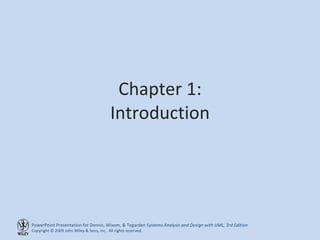Empfohlen
Empfohlen
Weitere ähnliche Inhalte
Was ist angesagt?
Was ist angesagt? (20)
Notes of Software engineering and Project Management

Notes of Software engineering and Project Management
Software Engineering Layered Technology Software Process Framework

Software Engineering Layered Technology Software Process Framework
Software engineering principles in system software design

Software engineering principles in system software design
Andere mochten auch
Andere mochten auch (7)
Ähnlich wie Ch01
Ähnlich wie Ch01 (20)
_773d48108e2dda1c1a731bf69b06c3be_Software-Architecture_Course-Notes.pdf

_773d48108e2dda1c1a731bf69b06c3be_Software-Architecture_Course-Notes.pdf
_773d48108e2dda1c1a731bf69b06c3be_Software-Architecture_Course-Notes.pdf

_773d48108e2dda1c1a731bf69b06c3be_Software-Architecture_Course-Notes.pdf
Mehr von 蕭美蓮
Ch01
- 3. Why Should We Care? Would you buy a car that only had a 28% chance of driving off the lot with no problems?
- 4. Recent Significant IT Failures
- 5. SYSTEMS DEVELOPMENT LIFE CYCLE
- 6. Systems Development Life Cycle
- 16. Structured Design 1 Waterfall Development
- 17. Structured Design 2 Parallel Development
- 18. Rapid Application Development 1 Phased Development
- 19. Rapid Application Development 2 System Prototyping
- 20. Rapid Application Development 3 Throwaway Prototyping
- 21. Agile Development Extreme Programming
- 22. Selecting the Right Methodology Usefulness for Waterfall Parallel Phased Prototyping Throwaway Prototyping Extreme Programming Unclear user requirements Poor Poor Good Excellent Excellent Excellent Unfamiliar technology Poor Poor Good Poor Excellent Poor Complex systems Good Good Good Poor Excellent Poor Reliable systems Good Good Good Poor Excellent Good Short time schedule Poor Good Excellent Excellent Good Excellent Schedule visibility Poor Poor Excellent Excellent Good Good
- 30. THE UNIFIED MODELING LANGUAGE
- 34. PROJECT TEAM ROLES AND SKILLS

